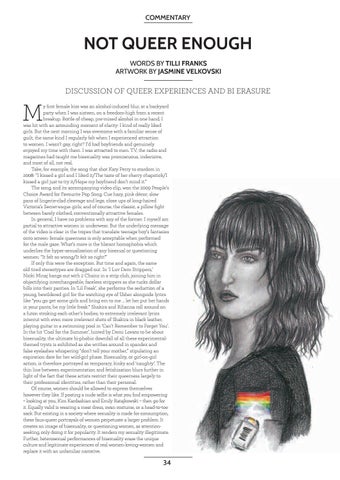COMMENTARY
NOT QUEER ENOUGH WORDS BY TILLI FRANKS ARTWORK BY JASMINE VELKOVSKI
DISCUSSION OF QUEER EXPERIENCES AND BI ERASURE
M
y first female kiss was an alcohol-induced blur, at a backyard party when I was sixteen, on a freedom-high from a recent breakup. Bottle of cheap, pre-mixed alcohol in one hand, I was hit with an astounding moment of clarity: I kind of really liked girls. But the next morning I was overcome with a familiar sense of guilt, the same kind I regularly felt when I experienced attraction to women. I wasn’t gay, right? I’d had boyfriends and genuinely enjoyed my time with them. I was attracted to men. TV, the radio and magazines had taught me bisexuality was promiscuous, indecisive, and most of all, not real. Take, for example, the song that shot Katy Perry to stardom in 2008: “I kissed a girl and I liked it/The taste of her cherry chapstick/I kissed a girl just to try it/Hope my boyfriend don’t mind it.” The song, and its accompanying video clip, won the 2009 People’s Choice Award for Favourite Pop Song. Cue hazy, pink décor; slow pans of lingerie-clad cleavage and legs; close ups of long-haired Victoria’s Secret-esque girls; and of course, the classic, a pillow fight between barely clothed, conventionally attractive females. In general, I have no problems with any of the former. I myself am partial to attractive women in underwear. But the underlying message of the video is clear in the tropes that translate teenage boy’s fantasies onto screen: female queerness is only acceptable when performed for the male gaze. What’s more is the blatant homophobia which underlies the hyper-sexualisation of any bisexual or questioning women: “It felt so wrong/It felt so right!” If only this were the exception. But time and again, the same old tired stereotypes are dragged out. In ‘I Luv Dem Strippers,’ Nicki Minaj hangs out with 2 Chainz in a strip club, joining him in objectifying interchangeable, faceless strippers as she tucks dollar bills into their panties. In ‘Lil Freak’, she performs the seduction of a young, bewildered girl for the watching eye of Usher alongside lyrics like “you go get some girls and bring em to me ... let her put her hands in your pants, be my little freak.” Shakira and Rihanna roll around on a futon stroking each other’s bodies, to extremely irrelevant lyrics intercut with even more irrelevant shots of Shakira in black leather, playing guitar in a swimming pool in ‘Can’t Remember to Forget You’. In the hit ‘Cool for the Summer’, hinted by Demi Lovato to be about bisexuality, the ultimate bi-phobic downfall of all these experimentalthemed trysts is exhibited as she writhes around in spandex and false eyelashes whispering “don’t tell your mother,” stipulating an expiration date for her wild-girl phase. Bisexuality, or girl-on-girl action, is therefore portrayed as temporary, kinky and ‘naughty’. The thin line between experimentation and fetishisation blurs further in light of the fact that these artists restrict their queerness largely to their professional identities, rather than their personal. Of course, women should be allowed to express themselves however they like. If posting a nude selfie is what you find empowering – looking at you, Kim Kardashian and Emily Ratajkowski – then go for it. Equally valid is wearing a meat dress, swan costume, or a head-to-toe sack. But existing in a society where sexuality is made for consumption, these faux-queer portrayals of women perpetuate a larger problem. It creates an image of bisexuality, or questioning women, as attentionseeking, only doing it for popularity. It renders my sexuality illegitimate. Further, heterosexual performances of bisexuality erase the unique culture and legitimate experiences of real women-loving-women and replace it with an unfamiliar narrative.
34
